Input interpretation

chlorobutylidene fluorobenzene
Basic properties
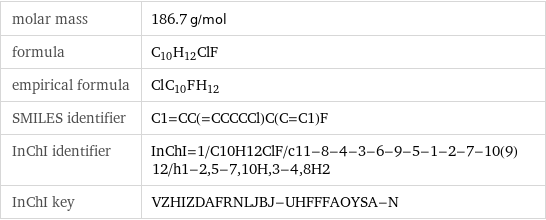
molar mass | 186.7 g/mol formula | C_10H_12ClF empirical formula | Cl_C_10F_H_12 SMILES identifier | C1=CC(=CCCCCl)C(C=C1)F InChI identifier | InChI=1/C10H12ClF/c11-8-4-3-6-9-5-1-2-7-10(9)12/h1-2, 5-7, 10H, 3-4, 8H2 InChI key | VZHIZDAFRNLJBJ-UHFFFAOYSA-N
Lewis structure
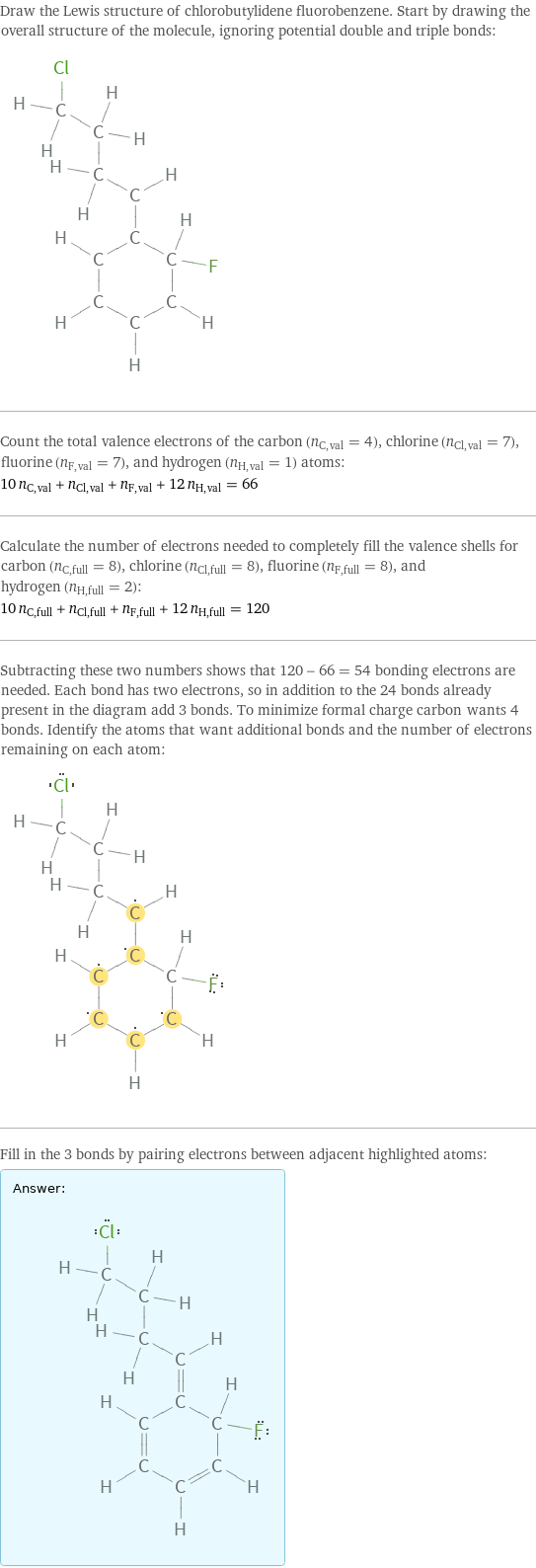
Draw the Lewis structure of chlorobutylidene fluorobenzene. Start by drawing the overall structure of the molecule, ignoring potential double and triple bonds: Count the total valence electrons of the carbon (n_C, val = 4), chlorine (n_Cl, val = 7), fluorine (n_F, val = 7), and hydrogen (n_H, val = 1) atoms: 10 n_C, val + n_Cl, val + n_F, val + 12 n_H, val = 66 Calculate the number of electrons needed to completely fill the valence shells for carbon (n_C, full = 8), chlorine (n_Cl, full = 8), fluorine (n_F, full = 8), and hydrogen (n_H, full = 2): 10 n_C, full + n_Cl, full + n_F, full + 12 n_H, full = 120 Subtracting these two numbers shows that 120 - 66 = 54 bonding electrons are needed. Each bond has two electrons, so in addition to the 24 bonds already present in the diagram add 3 bonds. To minimize formal charge carbon wants 4 bonds. Identify the atoms that want additional bonds and the number of electrons remaining on each atom: Fill in the 3 bonds by pairing electrons between adjacent highlighted atoms: Answer: | |
Estimated thermodynamic properties
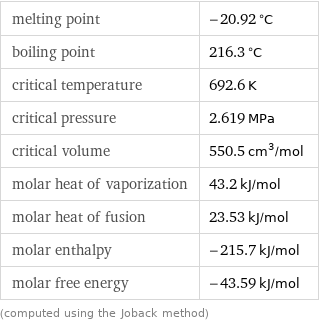
melting point | -20.92 °C boiling point | 216.3 °C critical temperature | 692.6 K critical pressure | 2.619 MPa critical volume | 550.5 cm^3/mol molar heat of vaporization | 43.2 kJ/mol molar heat of fusion | 23.53 kJ/mol molar enthalpy | -215.7 kJ/mol molar free energy | -43.59 kJ/mol (computed using the Joback method)
Units

Quantitative molecular descriptors
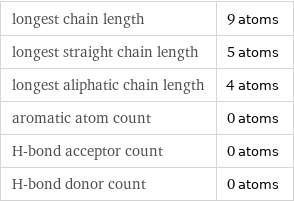
longest chain length | 9 atoms longest straight chain length | 5 atoms longest aliphatic chain length | 4 atoms aromatic atom count | 0 atoms H-bond acceptor count | 0 atoms H-bond donor count | 0 atoms
Elemental composition

Find the elemental composition for chlorobutylidene fluorobenzene in terms of the atom and mass percents: atom percent = N_i/N_atoms × 100% mass percent = (N_im_i)/m × 100% Plan: • Write the chemical formula and gather atomic masses from the periodic table. • Determine values for N_i, m_i, N_atoms and m using these items. • Finally, compute the percents and check the results. Write the chemical formula: C_10H_12ClF Use the chemical formula to count the number of atoms, N_i, for each element and find the total number of atoms, N_atoms, per molecule: | number of atoms Cl (chlorine) | 1 C (carbon) | 10 F (fluorine) | 1 H (hydrogen) | 12 N_atoms = 1 + 10 + 1 + 12 = 24 Divide each N_i by N_atoms to calculate atom fractions. Then use the property that atom fractions must sum to one to check the work: | number of atoms | atom fraction Cl (chlorine) | 1 | 1/24 C (carbon) | 10 | 10/24 F (fluorine) | 1 | 1/24 H (hydrogen) | 12 | 12/24 Check: 1/24 + 10/24 + 1/24 + 12/24 = 1 Compute atom percents using the atom fractions: | number of atoms | atom percent Cl (chlorine) | 1 | 1/24 × 100% = 4.17% C (carbon) | 10 | 10/24 × 100% = 41.7% F (fluorine) | 1 | 1/24 × 100% = 4.17% H (hydrogen) | 12 | 12/24 × 100% = 50.0% Look up the atomic mass, m_i, in unified atomic mass units, u, for each element in the periodic table: | number of atoms | atom percent | atomic mass/u Cl (chlorine) | 1 | 4.17% | 35.45 C (carbon) | 10 | 41.7% | 12.011 F (fluorine) | 1 | 4.17% | 18.998403163 H (hydrogen) | 12 | 50.0% | 1.008 Multiply N_i by m_i to compute the mass for each element. Then sum those values to compute the molecular mass, m: | number of atoms | atom percent | atomic mass/u | mass/u Cl (chlorine) | 1 | 4.17% | 35.45 | 1 × 35.45 = 35.45 C (carbon) | 10 | 41.7% | 12.011 | 10 × 12.011 = 120.110 F (fluorine) | 1 | 4.17% | 18.998403163 | 1 × 18.998403163 = 18.998403163 H (hydrogen) | 12 | 50.0% | 1.008 | 12 × 1.008 = 12.096 m = 35.45 u + 120.110 u + 18.998403163 u + 12.096 u = 186.654403163 u Divide the mass for each element by m to calculate mass fractions. Then use the property that mass fractions must sum to one to check the work: | number of atoms | atom percent | mass fraction Cl (chlorine) | 1 | 4.17% | 35.45/186.654403163 C (carbon) | 10 | 41.7% | 120.110/186.654403163 F (fluorine) | 1 | 4.17% | 18.998403163/186.654403163 H (hydrogen) | 12 | 50.0% | 12.096/186.654403163 Check: 35.45/186.654403163 + 120.110/186.654403163 + 18.998403163/186.654403163 + 12.096/186.654403163 = 1 Compute mass percents using the mass fractions: Answer: | | | number of atoms | atom percent | mass percent Cl (chlorine) | 1 | 4.17% | 35.45/186.654403163 × 100% = 18.99% C (carbon) | 10 | 41.7% | 120.110/186.654403163 × 100% = 64.35% F (fluorine) | 1 | 4.17% | 18.998403163/186.654403163 × 100% = 10.18% H (hydrogen) | 12 | 50.0% | 12.096/186.654403163 × 100% = 6.480%
Elemental oxidation states

The first step in finding the oxidation states (or oxidation numbers) in chlorobutylidene fluorobenzene is to draw the structure diagram. Next set every oxidation number equal to the atom's formal charge: In chlorobutylidene fluorobenzene hydrogen is not bonded to a metal with lower electronegativity, so it will have an oxidation state of +1. Any element bonded to hydrogen gains the bonding electrons, decreasing their oxidation state by 1 for every bond: With hydrogen out of the way, look at the remaining bonds. There are 1 carbon-chlorine bond, 1 carbon-fluorine bond, and 10 carbon-carbon bonds. For each of these bonds, assign the bonding electrons to the most electronegative element. First examine the carbon-chlorine bond: element | electronegativity (Pauling scale) | C | 2.55 | Cl | 3.16 | | | Since chlorine is more electronegative than carbon, the electrons in this bond will go to chlorine. Decrease the oxidation number for chlorine (by 1 for single bonds, 2 for double bonds, and 3 for triple bonds), and increase the oxidation number for carbon accordingly: Next look at the carbon-fluorine bond: element | electronegativity (Pauling scale) | C | 2.55 | F | 3.98 | | | Since fluorine is more electronegative than carbon, the electrons in this bond will go to fluorine: Next look at the carbon-carbon bonds: element | electronegativity (Pauling scale) | C | 2.55 | C | 2.55 | | | Since these elements are the same the bonding electrons are shared equally, and there is no change to the oxidation states: Now summarize the results: Answer: | | oxidation state | element | count -2 | C (carbon) | 2 -1 | C (carbon) | 6 | Cl (chlorine) | 1 | F (fluorine) | 1 0 | C (carbon) | 2 +1 | H (hydrogen) | 12
Orbital hybridization

First draw the structure diagram for chlorobutylidene fluorobenzene, and for every non-hydrogen atom, count the σ-bonds. Note that double and triple bonds consist of one σ-bond together with one or two π-bonds: Identify those atoms with lone pairs: Find the steric number by adding the lone pair count to the number of σ-bonds: Consult the following chart to determine the hybridization from the steric number: steric number | hybridization 2 | sp 3 | sp^2 4 | sp^3 5 | dsp^3 6 | d^2sp^3 7 | d^3sp^3 Now assign the hybridization for each atom: Answer: | |
Topological indices
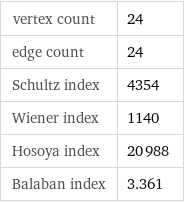
vertex count | 24 edge count | 24 Schultz index | 4354 Wiener index | 1140 Hosoya index | 20988 Balaban index | 3.361